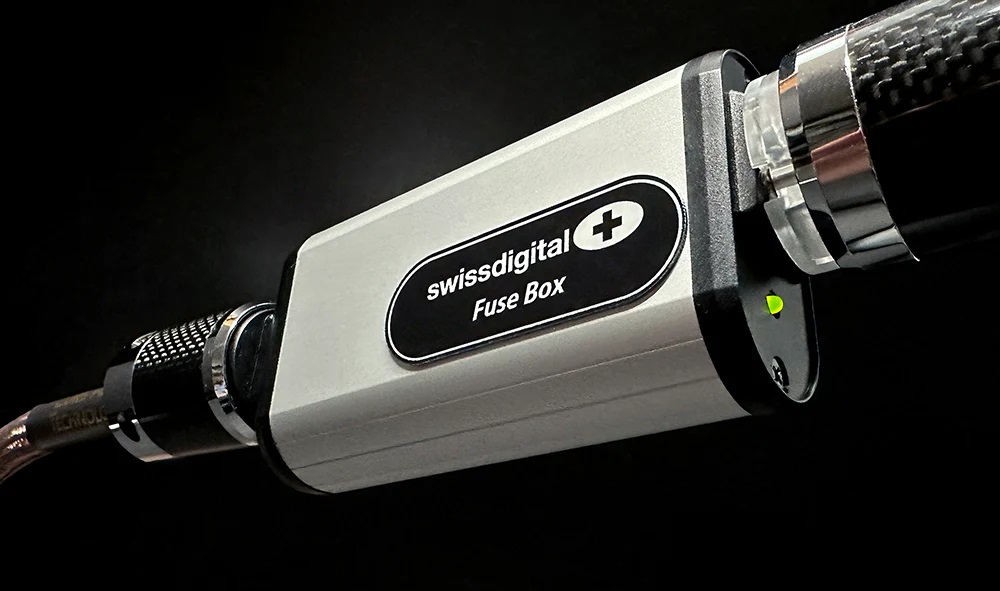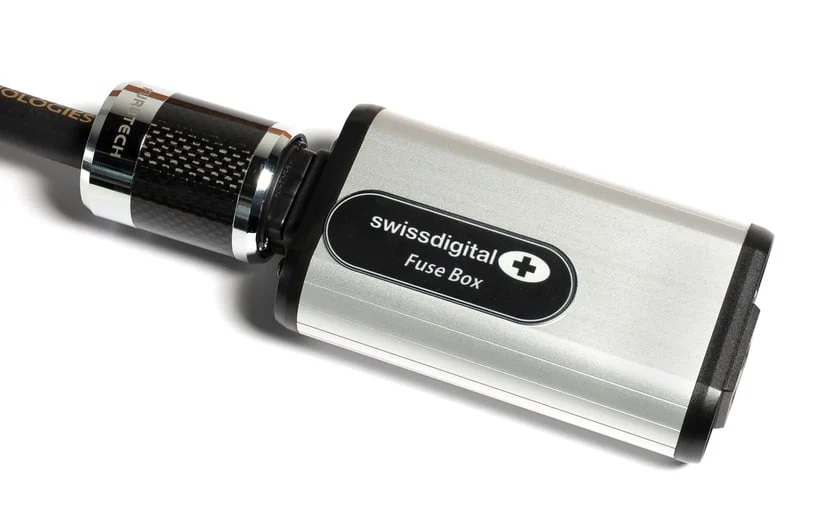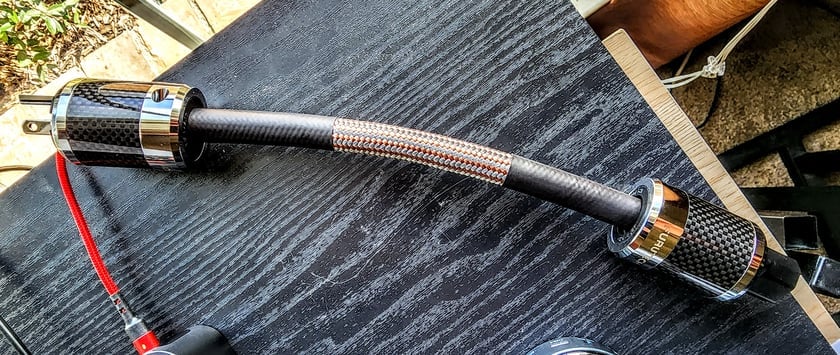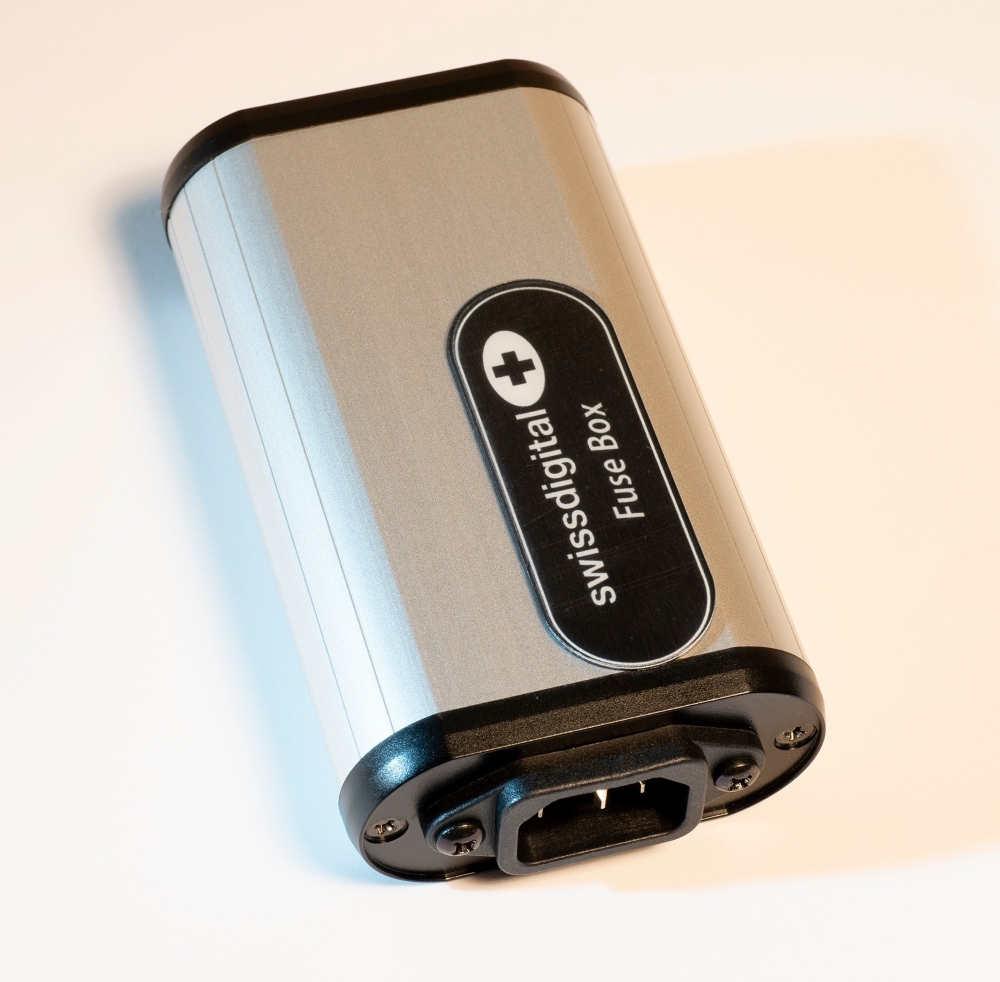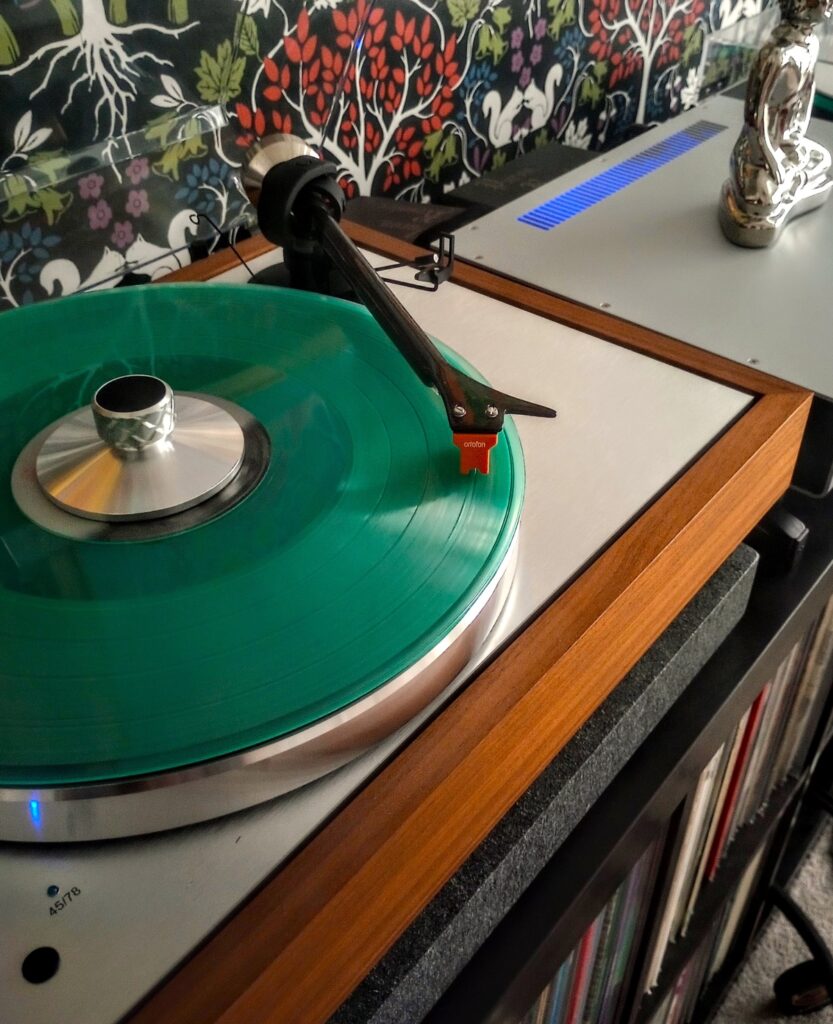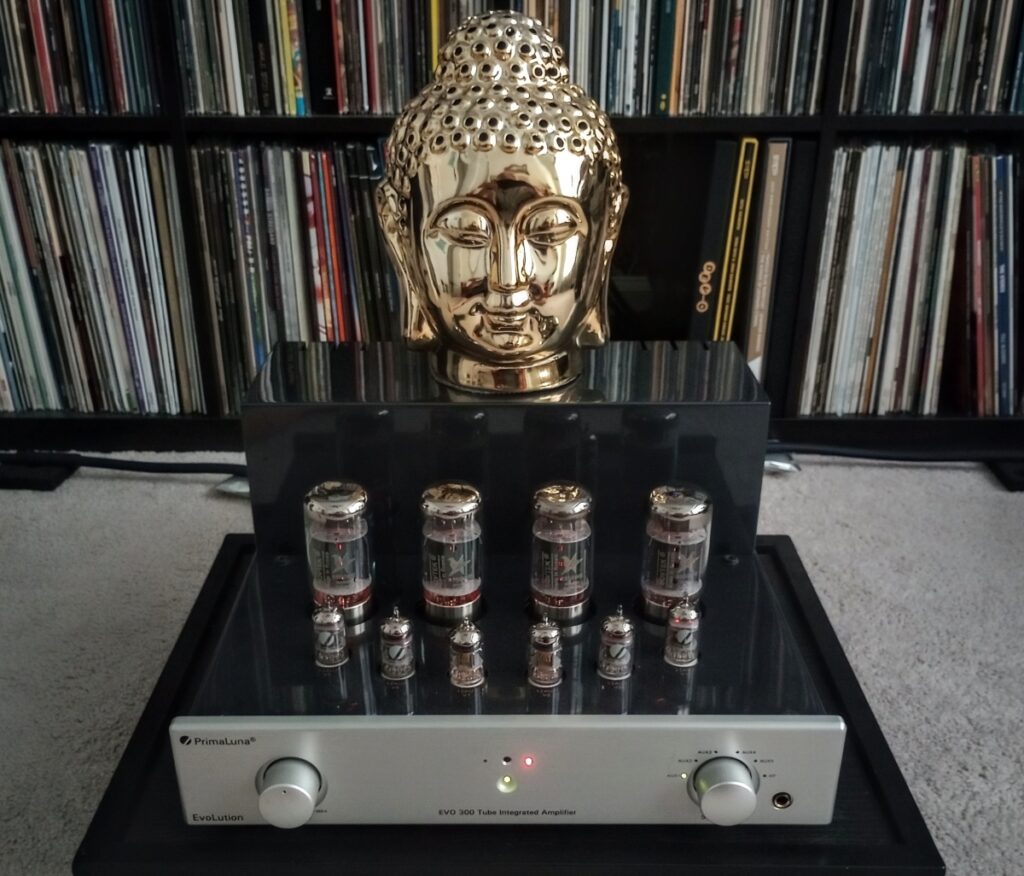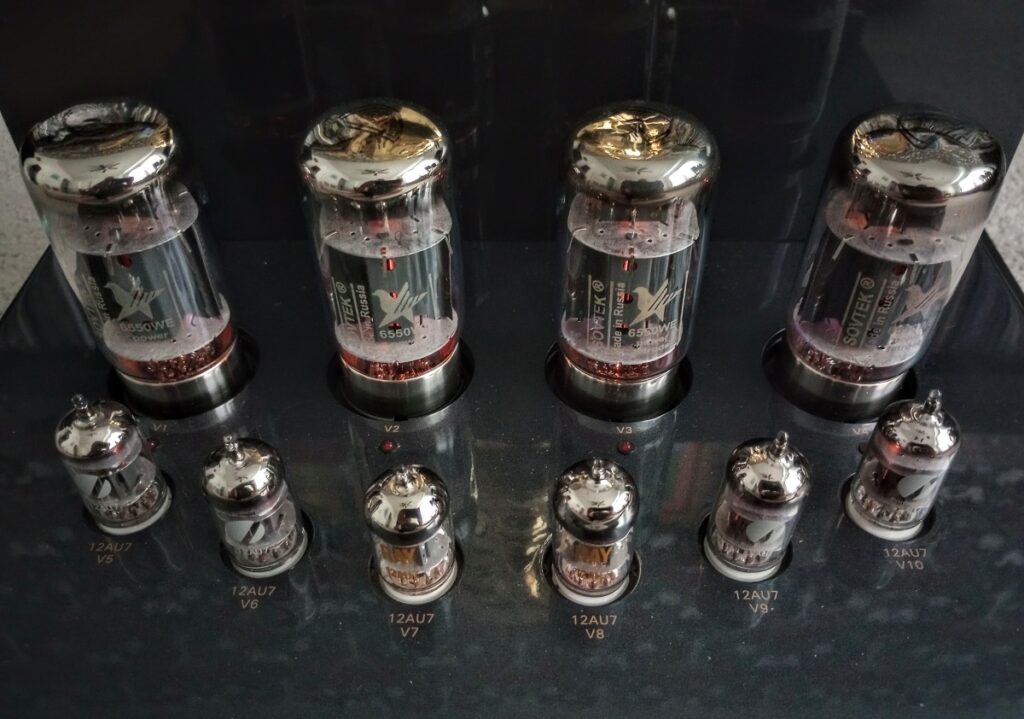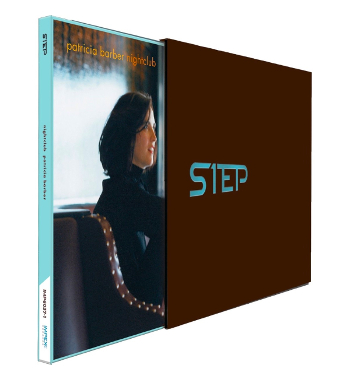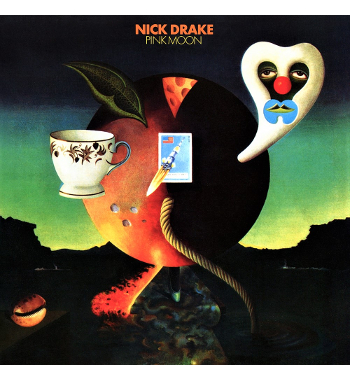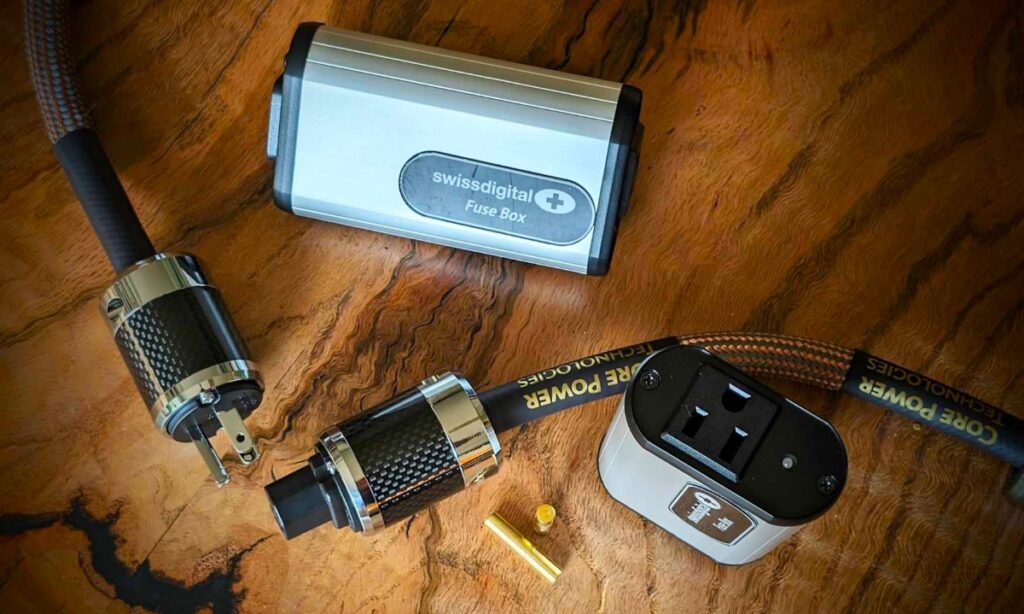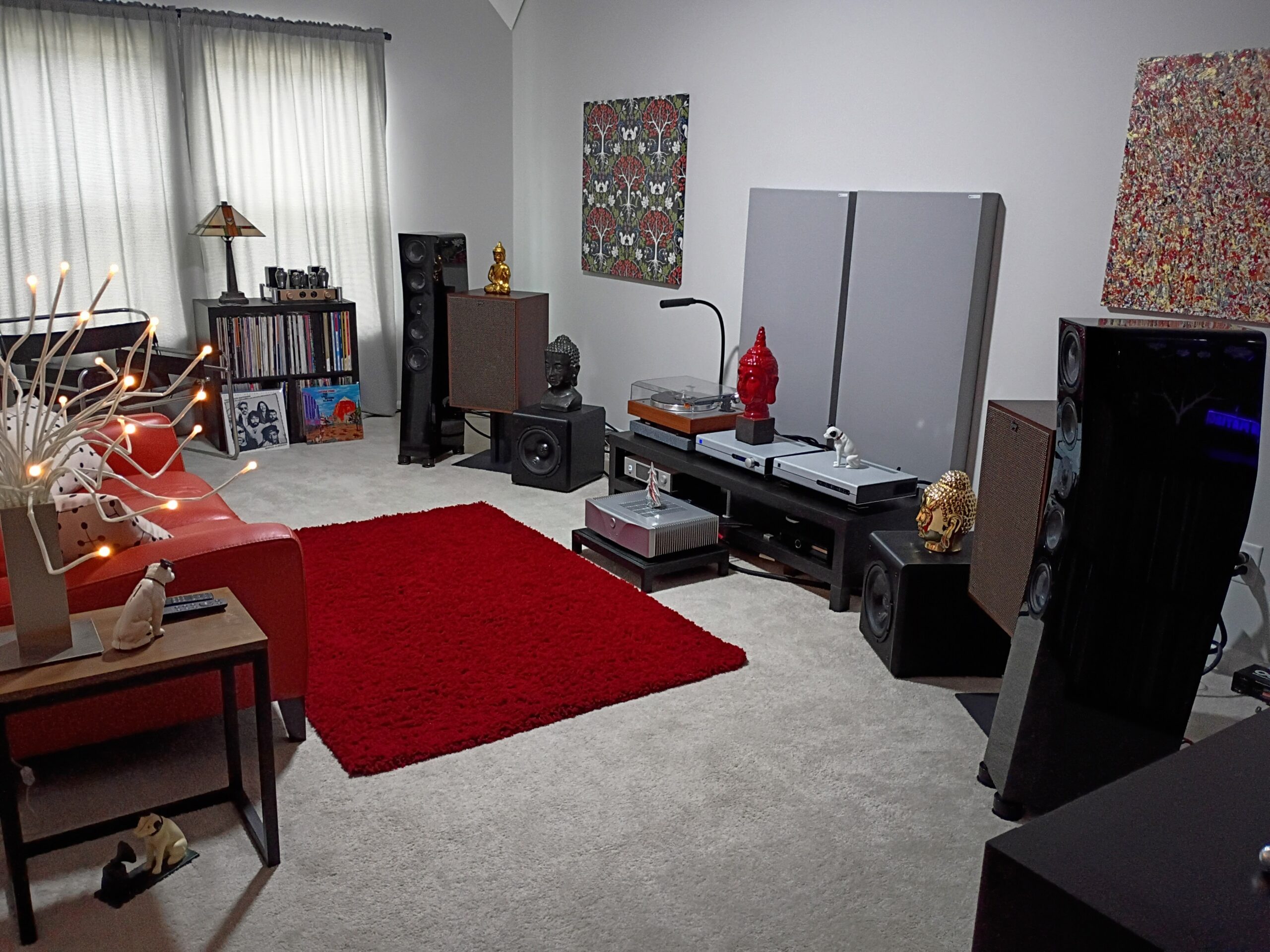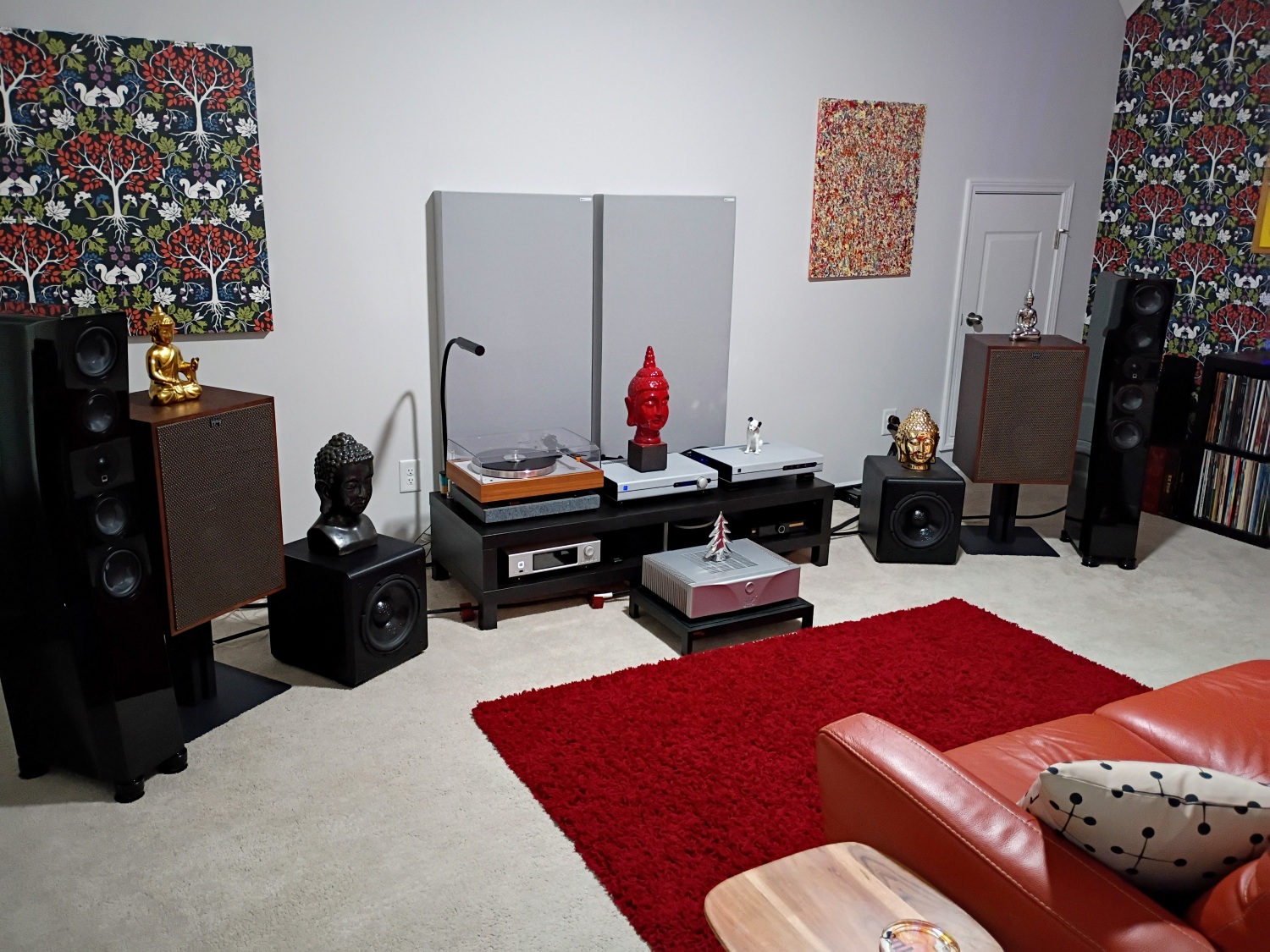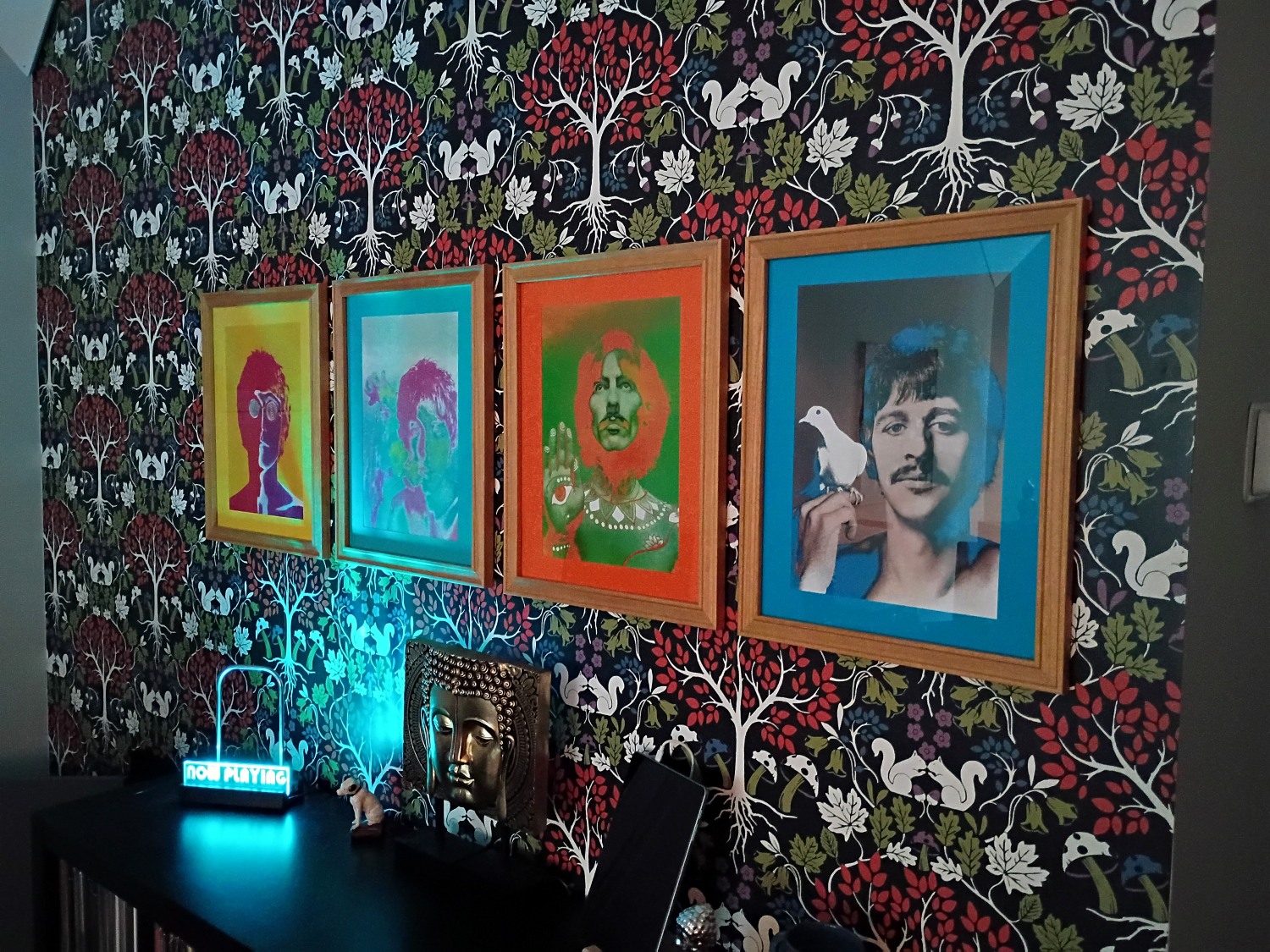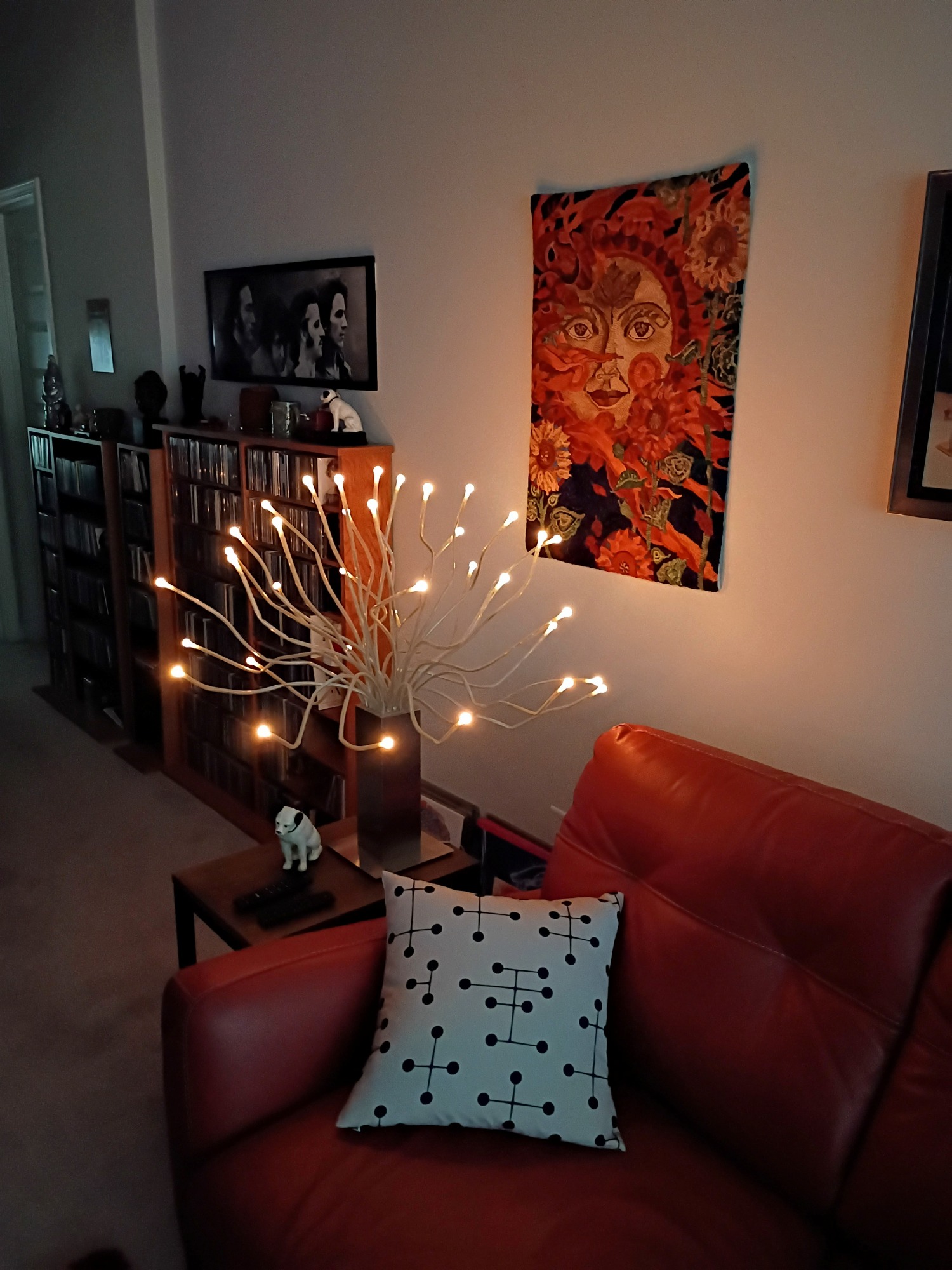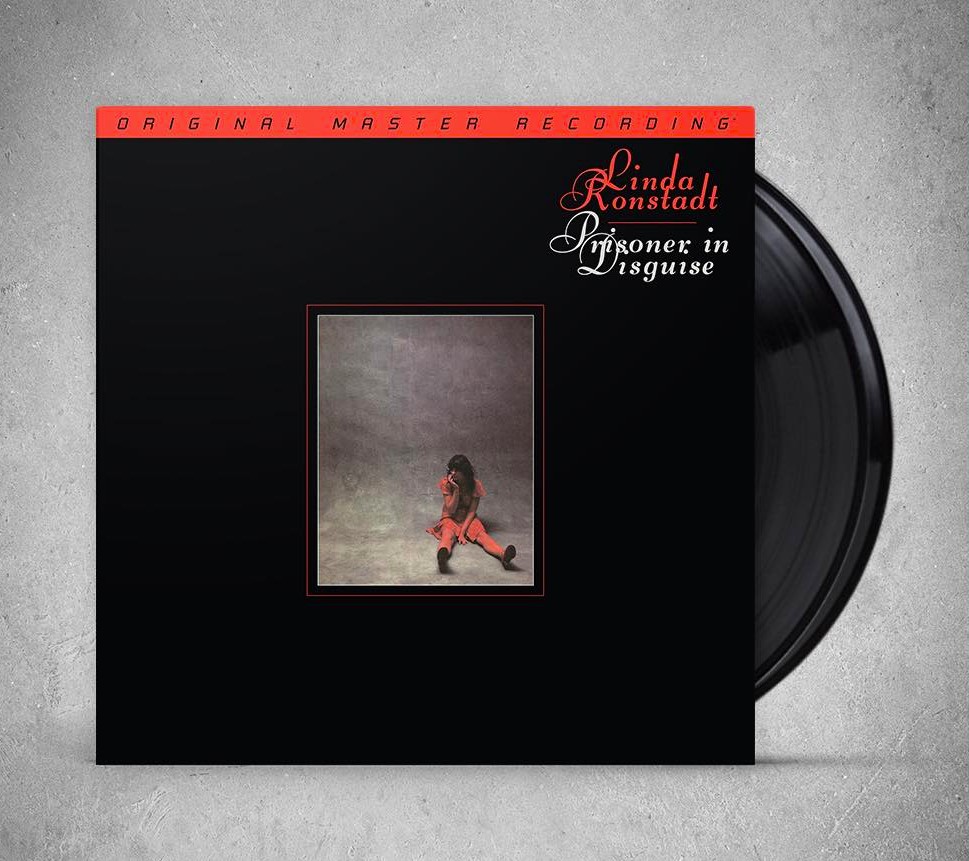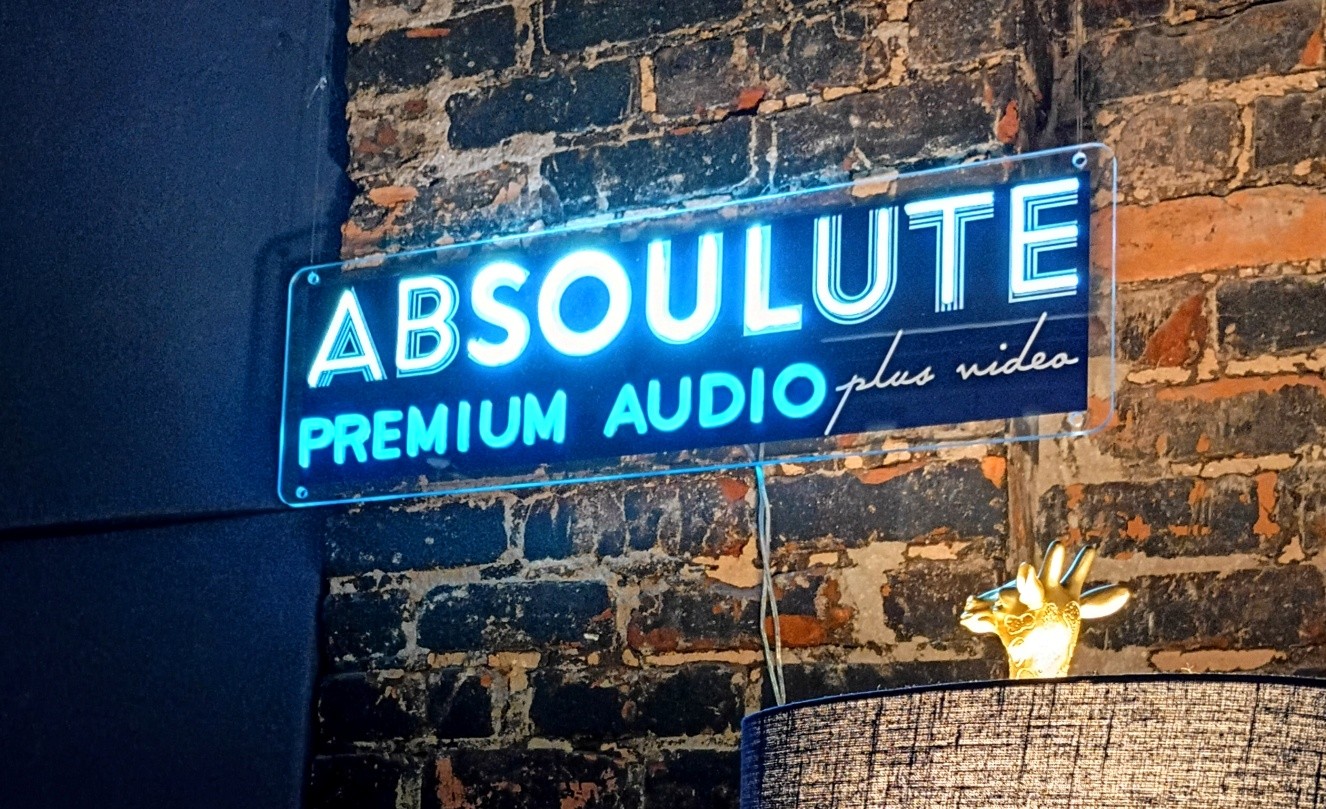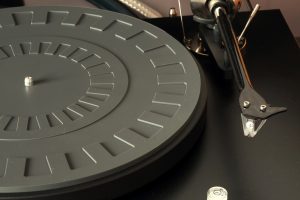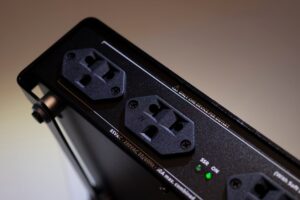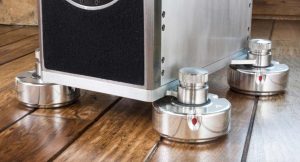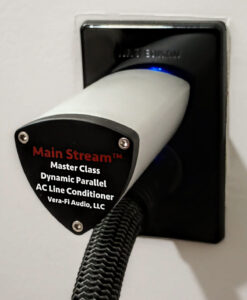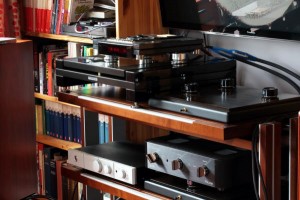Over my life as an audiophile, I've had three individual instances where I was absolutely certain beyond doubt that the consequences of my actions would in no time send me rocketing down the highway to high-end audio hell. The first came over a decade ago when I followed the advice I'd gotten from another audio journalist and bypassed the fuse block on my Magneplanar loudspeaker tweeters. Which was a clear violation of Magnepan's product warranty, and could easily damage the tweeter panels. Having owned a number of Magneplanar models over a period of several decades, I basically had been buying replacement fuses by the case, and blowing through them like a kid in a candy store. When, as a result of my excessive enthusiasm for the music, any opportunity that arose for me to slightly push the volume level always ended with a blown fuse. The logic offered for the fuse bypass was highly plausible; the signal coming from your amp to your loudspeakers is very likely supplied by speaker cables the size of a garden-hose. But that signal is then passed through a fast-blow fuse with a microscopically thin element that's only slightly larger than a human hair, enroute to the Magneplanar's internal wiring. Which was substantially more robust from the fuse block through the crossover elements to the planar magnetic panels. Of course, this all hinged upon the ability of your amplifier to sufficiently supply the clean and high current watts all Maggies crave. Among the advantages offered by the fuse bypass were improved midrange and treble clarity, increased power handling, and a more clearly defined soundstage. I looked at the bypass diagram with great skepticism for about a year before I finally manned-up and pulled the trigger. And I've never looked back, having bypassed every pair I've owned since—it's absolutely essential to obtaining optimal high frequency performance. The wrath of the underworld averted for the time being, but I was feeling the heat, and was definitely sweating it!
The second instance occurred during my early explorations into computer audio and digital streaming, when my music player and library organizer was JRiver Media Player. As I was learning the ropes of CD ripping, file management, ID tagging, and computer optimization, I also spent a fair amount of time surfing through JRiver's forums for tips and information. A frequent thread throughout the forums demonized a software known as JPLAY, which JRiver's principals seemed to think was not only dangerous to your computer, but also shamelessly capitalized on the "J" in their name. Curiosity got the best of me, and I researched the in's and out's of JPLAY, which struck me as being not only darkly mysterious, but also technically beyond my grasp. And JPLAY was vilified at that time in just about every corner of the internet by plenty of naysayers. I'd decided to avoid it at all costs—that is until JPLAY's Marcin Ostapowicz reached out to me from the heart of Poland with an unexpected review opportunity. I responded with a lengthy explanation regarding why I shouldn't accept, but Marcin would not be denied, and assured me that JPLAY was completely reversible, wouldn't harm my system, and would improve the sound quality of my digital music playback exponentially. I was certain I was being hoodwinked, and that loading JPLAY would undoubtedly cripple my computer; I waffled for days before pressing the install button. Of course, it performed phenomenally, and at that point in my journey, JPLAY was indispensable to my enjoyment of computer-based digital audio. That said, taking the leap of faith necessary to install it on my computer caused me quite a bit of hellish consternation, but Marcin's superb software and cutting edge devices are definitely still at the vanguard of digital music playback.
My most recent brush with the audio abyss came less than a week ago when Mark Schifter of Vera-Fi Audio offered to send a Swiss Digital Fuse Box (SDFB) device to me for evaluation. On the surface, the SDFB appeared to be totally innocuous—perhaps it's an inline AC filter of sorts? Further online investigation quickly informed me that once again I'd soon be entering into the realm of "WARNING!! You can hurt yourself or damage your equipment!" territory. Great…and here we go on another wacky adventure!
The Theory Behind the Swiss Digital Fuse Box
As I mentioned in my lead-in above, I have quite a bit of experience from the loudspeaker side regarding fuses and their implementation. I constantly blew fuses in my Magneplanars with regularity, and I often reflected on what could possibly be the source of the problem. Here's part of the rub: while Magnepan has for decades marketed their loudspeakers as "a fairly easy load to drive," nothing could be further from the truth, and attempting to get great sound from them with a mid-fi receiver or integrated amp is an act of pure folly. At about the halfway point of my forty-year experience as a Magneplanar owner, the light bulb suddenly blazed on, and I figured out that I needed an amplifier that could provide plenty of high-current, clean watts to even get a hint of the kind of performance they were capable of. And then I read the article concerning the tweeter fuse bypass, which also went into a philosophical explanation as to why the bypass made perfect sense. Mainly with regards to the signal getting squeezed through the microscopically small fuse filament while heading to your speaker panels. From my own decades of bad experiences with fuses, the logic seemed very sound, and in practice, it's been perfect.
So when I realized that the concept of the Swiss Digital Fuse Box works in a similar manner, it also made perfect sense to me. Your aftermarket, garden-hose sized AC power cable probably contains wiring that's AWG 10 or 12, and it's attempting to feed a steady flow of current into an amplifier or other device that's protected by a fuse that restricts the incoming current flow significantly. Down to the point where it's flowing into the power supply of your device through a fuse with an element about the size of a straight pin. Conceptually, it's concerning that the fuse is obviously the weakest link in the flow of AC power from your wall outlet to your device. Which in my case, I had decided would be my PrimaLuna EVO 300 tube integrated amplifier, as it appears to me that the Naiu Labs Ella amplifier in my digital system has a fuse rating that's currently beyond the capacity of the SDFB. With the kind of performance gains I've experienced by bypassing the fuse in my Magneplanar loudspeakers, why shouldn't eliminating the fuse from anything else mirror those results?
Here's some verbiage from Vera-Fi Audio's website concerning the theory behind the Swiss Digital Fuse Box design: "A fuse is a very simple and elegant safety device. AC Mains current flows through it on its way from your home's wall outlet to the power supply of your audio product. By design, the current flowing through it causes the fuse filament to get warm because it is, in fact, a small value resistor. It uses Ohm's Law and the concept of resistance heating (just like your toaster) to protect you. As the current through it increases, the heating of the element increases, until the conducted current exceeds its current rating, when, ultimately, it burns through and opens the circuit. If you examine a typical fuse you will see that lower rated fuses have smaller internal elements than ones of a higher current rating. One can infer from that observation that smaller value fuses have higher resistance than larger, and that is, in fact, the case, as easily shown by a precision Ohm meter. But that's not the whole story, because you are measuring the fuse under "cold" conditions—with no current flowing through it. As current flows and the element heats, its resistance increases, up to the point of failure."
"Now, let's examine how your audio product reacts to a fuse's natural characteristics. When you initially power on your product the current draws are high as the capacitors charge up and the active elements begin to conduct. This period is called the "inrush" and the fuse is sized to allow this amount of current to pass; the element will heat up very briefly, but soon return to a steady state or normal operations phase which is typically a much lower current value. In some cases, an equipment manufacturer might specify a "slow blow" fuse, if it knows the inrush current requirement of the product could exceed the brief capacity of a normal "fast blow" type of fuse. Regardless, the principal is the same. Where the fuse becomes important of course, is from a safety perspective. If there is some fault in the product that causes the current draw to exceed the fuse rating. Under that condition the fuse will continue to heat so long as the excess current draw is maintained, forcing it ultimately to blow, as we described above. While good as a safety device, the characteristics of a fuse are not optimum for audio performance…the Swiss Digital Fuse Box is designed to eliminate all of the drawbacks of a common fuse."
The Swiss Digital Fuse Box takes the place of the power supply fuse in any audio device. Currently, only a specific range of amperage and fuse sizes can be accommodated, but I understand from Mark Schifter that additional compatibility ranges are in the works. What's necessary on the user end is to supply Vera-Fi with the fuse type (slow/fast blow), dimensions, amperage rating, and the device voltage (120/220V). This means that the SDFB is built specifically for use with the particular device it's being ordered for, and isn't interchangeable with other devices in your audio rig. It contains a microprocessor that's programmed to meet the stated fuse needs of your specific device, and once connected to your system, senses the compatibility it's programmed for. It then proceeds to provide the continuous protection to your equipment that would otherwise have been left up to the lowly power supply fuse.
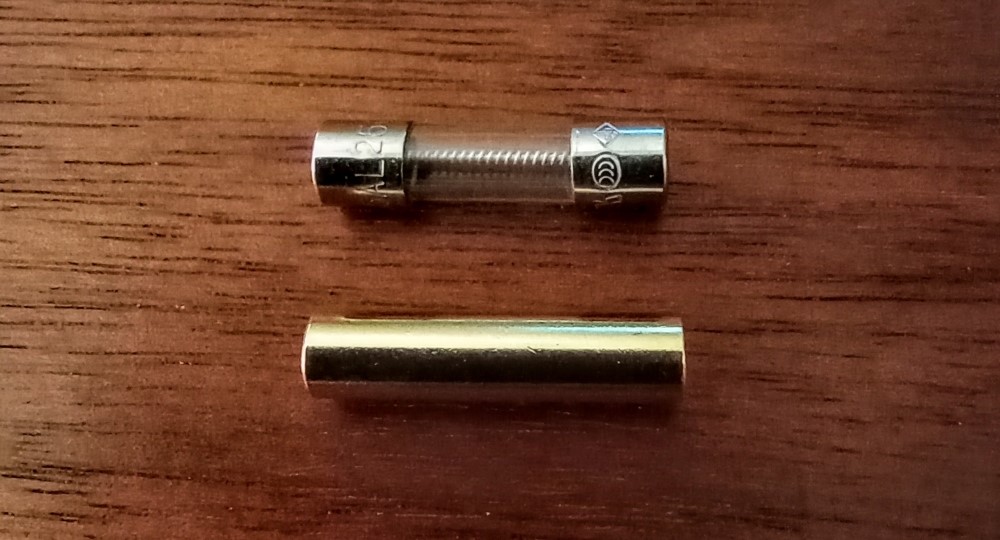
The mass of the Super Sluggo is significantly more robust than that of the fuse's protective element.
So what happens to the existing fuse? The Swiss Digital Fuse Box also includes a solid copper, nickel, or gold plated copper length of rod Mark calls the "Sluggo" that's intended to replace the fuse currently installed in your device. The Sluggo matches the dimensions of the fuse it replaces perfectly, but because it's a solid metal rod, it measures somewhere in the neighborhood of AWG 4, which is substantially larger than the AWG rating of the aftermarket power cord feeding it from the AC line. Remembering that the lower the AWG number, the larger the diameter of the wire, so with the Sluggo in place, no current limiting is taking place between the power cord and your device. According to Vera-Fi's website "[The] Sluggo…has negligible resistance and can pass currents you are unlikely to see in any audio product—certainly more than a hundred amps—before heating." Which also means that with the SDFB providing protection, the Sluggo will allow an unhindered flow of AC current to your amplifier or other device. Of course, there are numerous warnings in the supplied literature and online about the danger of attempting to operate your equipment with just a Sluggo inserted, but without the SDFB in place, which could easily overheat the Sluggo and cause a catastrophic fire. We're talking actual flames here!
Setup of the Swiss Digital Fuse Box in My Analog System
The Swiss Digital Fuse Box showed up just as I was about to head out of town for a few days, and after reading the explicit warning that accompanies the device, that's the first point when I felt my stomach churn. Just to make things perfectly clear, you must follow the installation instructions to the letter, observing every detail of every step during the process. It's not that it's a difficult installation—it's not—it's just when you're given very stern warnings along the lines of "WARNING!! You can hurt yourself or damage your equipment!", it kind of grabs your attention!
The Swiss Digital Fuse Box setup supplied to me included the Fuse Box, which has an IEC 320 standard input on one end of the device, along with a NEMA 5-15 three-prong outlet on the other end. There's also an LED status light that's placed on the NEMA outlet end, which allows for you to easily see if the device is functioning correctly during setup and operation. I received the option that includes a Core Power "Piggy Tail," which is an exceptionally well-made short length (12 inches or so) of robust power cord that's fitted with Furutech connectors. It's expected that your device is already connected with a high quality aftermarket power cable—my PrimaLuna EVO 300 tube integrated amp is connected to the AudioQuest Niagara 1200 conditioning unit with an AudioQuest Blizzard w/DBA power cord. In the absence of the Piggy Tail, you'll need to supply another power cord, hopefully on par with the one currently connecting your device to the AC. Also included in the box was a pair of Vera-Fi's Super Sluggos, which is the 24k Gold plated solid copper version; it's the current top-of-the-line Sluggo, but Vera-Fi is on the verge of marketing a version that's treated with Graphene (more on that in the follow-up to this review coming shortly!).

The supplied installation instruction sheet offers a very abrupt warning that got my knickers a bit twisted at the outset: "If you are having second thoughts, please STOP RIGHT HERE AND DO NOT OPEN THE SEALED BAG CONTAINING THE FUSE BOX. BY OPENING THIS BAG, YOU ARE ACCEPTING ALL RESPONSIBILITY FOR ITS USE."
That was reassuring! I stared at the warning for a few minutes (is it getting warm in here?), then tore open the bag and proceeded with the installation. The first step is to unplug your device from the AC power source, making totally certain that the device power switch is set to "OFF." You then need to locate the housing for your device's power supply fuse and double check the fuse value—though, honestly, if you're at this stage of the game, you should have already removed the fuse and checked it prior to ordering the SDFB. However, I did again confirm that the fuse size listed on the back panel of my PrimaLuna EVO 300 matched the actual fuse contained within. I then visually compared the fuse to the Super Sluggo; they matched perfectly, so I then inserted the Super Sluggo into the fuse compartment of the amp. And simply as a reminder, removing the fuse from your equipment will void it's factory warranty should anything untoward happen (does anyone else feel like it's getting hotter in here?).
By the time I'd reached this point of the installation process, I didn't feel that the instructions clearly spelled out the correct connection sequence and desired placement of the Swiss Digital Fuse Box in the device power cord/SDFB/Piggy Tail chain. I reached out to Mark about this, and he recommended plugging the Piggy Tail into the wall outlet or your power conditioner. And the correct sequence during setup is to reconnect your device's AC power cord, then connect it to the NEMA outlet on the SDFB. The Piggy Tail is then connected to the IEC input on the SDFB; the final step of the sequence is to connect the Piggy Tail to your AC power source.
Upon plugging the Piggy Tail into one of the Niagara 1200's high current outlets, the LED on the Fuse Box started blinking green in random bursts, then settled to a solid green glow, meaning that the microprocessor had read the signal requirements and matched them to the programming of the Fuse Box unit. According to the instructions, a solid green light indicates that you're good to go, and you can now turn on the power switch on your device. Should the SDFB shut down at that point, you should unplug the device from the mains, wait one minute, and attempt the sequence again. Should it happen twice, that indicates that either there's a fault with your equipment, or that perhaps the SDFB was programmed incorrectly. Either way, you'll need to reach out to Vera-Fi to get their input into the situation; fortunately, mine glowed green very quickly, and I turned on the EVO 300 without issue. So far, so good!
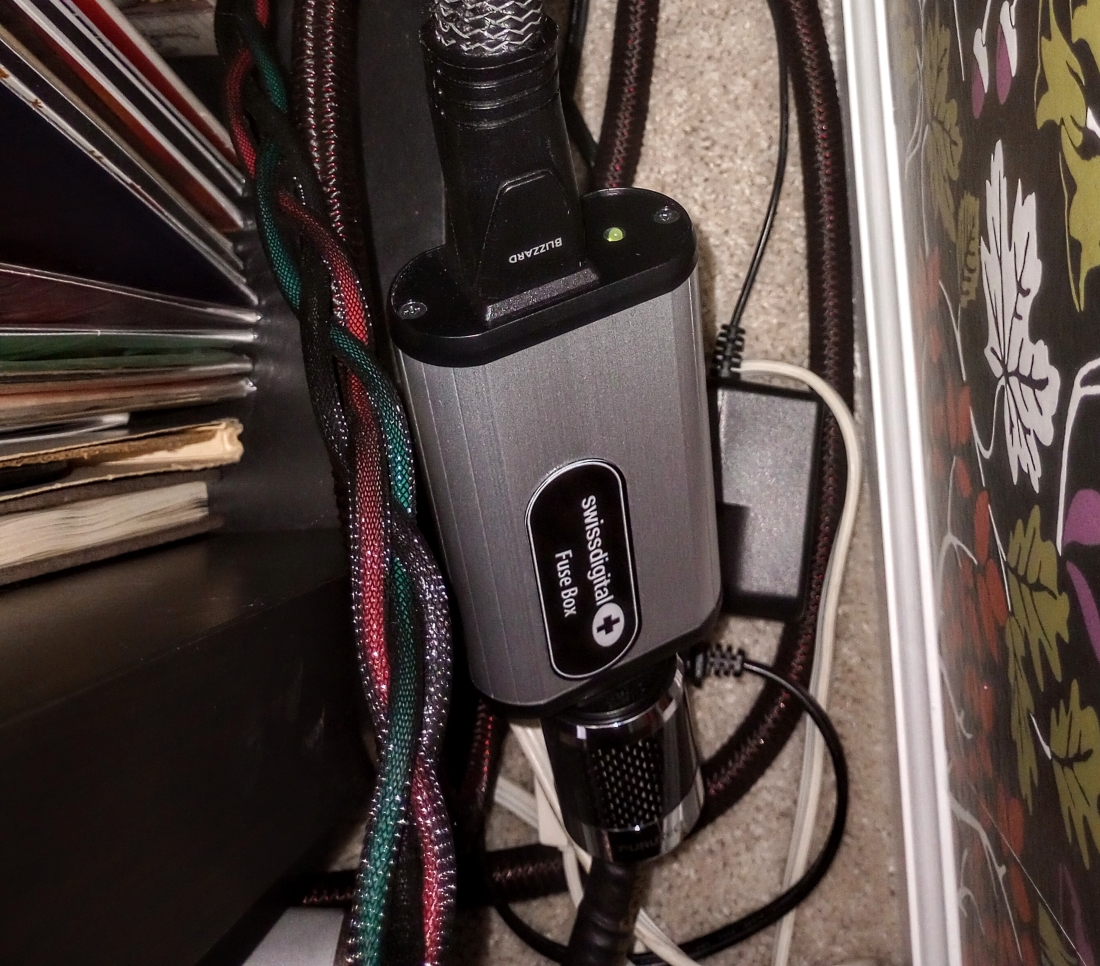
Mark had told me that the Swiss Digital Fuse Box would definitely benefit from some burn-in. Because I was on the verge of heading out of town for almost a week, I only attempted the initial burn-in for a brief period prior to my departure. As is my usual practice in the analog room, I attached my Fiio M9 digital audio player's line out to one of the PrimaLuna inputs and set it to run on repeat for about five hours the day it showed up, then again for about five hours the next day. After we returned from our excursion, I again set the dap to repeat and let it play for long stretches over a two day period. Now we're ready to listen to some music!
Evaluating the Swiss Digital Fuse Box in My Analog System
As always, you can click on my name in the header above and see the complement of equipment in both of my audio systems. When sending Mark the specifications for the Swiss Digital Fuse Box he'd be preparing for me, I decided that I wanted to get my first impressions on my all-analog system, where the only complement of electronics in the room is the PrimaLuna EVO 300 amp, the PS Audio Stellar phono preamp, and the AudioQuest Niagara 1200 conditioner. I felt the PrimaLuna was the best starting point, and after that evaluation, perhaps we'd think about a different direction next go-around. I'd probably think the Stellar phono preamp might be the next up for a go at an SDFB, but I definitely have questions for Mark regarding that implementation, which would be sometime down the road. Since the SDFB sent to me was programmed specific to the EVO 300, this won't be one of those evaluations where I move the review device from system to system to check out its effectiveness on any other equipment. And besides, the analog room has the complement of Vanguard Scout/Caldera loudspeakers and sub I'm currently infatuated with, so it's really the best place to start.
The PrimaLuna EVO 300 tube integrated has been in my system for four years now, and back in March, I upgraded the tube complement to a matched quad of premium Gold Lion KT77 power tubes along with a matched pair of vintage, NOS Brimar 12AU7 input tubes. I also ordered a spare set of power tubes, a matched quad of Sovtek 6550's, and about the same time all this was happening, a review pair of Apos Audio's new premium Apos RAY 12AU7 input tubes also showed up. Three weeks later, one of the KT77's inexplicably died, and while I was waiting for a warranty replacement, I switched out the power and input tubes to the Sovteks and Apos Rays (it was a good opportunity to run them in for their upcoming evaluation). They've been in operation for a month now, and I've developed a very good sense of how they sound in my system—which is pretty phenomenal! I'm currently leaning towards keeping them in the system; the Sovtek power tubes use a higher bias setting, and produce a few more watts, but actually sound much more musically dynamic and are perhaps better matched to the Vanguard Scout loudspeakers than the Gold Lion tubes. That said, none of the new tube euphoria could have prepared me for what I was about to hear with the Swiss Digital Fuse Box inline with the EVO 300!




